Essay on Second Language Teaching: Approaches and Comparative Analysis
VerifiedAdded on 2022/08/12
|9
|2603
|362
Essay
AI Summary
This essay provides an in-depth analysis of contemporary approaches to second language teaching, focusing on methods such as Communicative Language Teaching (CLT) and the Natural Approach. The essay defines the key features of these modern approaches, illustrating them with examples of language use, spoken interactions, and written communication. It then offers a detailed comparison and contrast of these contemporary methods with the traditional Grammar Translation Method, highlighting the strengths and weaknesses of each approach. The discussion covers the theoretical underpinnings, practical applications, and pedagogical implications of each method, providing a comprehensive understanding of the evolution and current landscape of second language teaching. The essay considers the impact of each approach on student learning and language acquisition, offering insights into effective teaching strategies and the importance of adapting methods to diverse learning contexts and student needs.
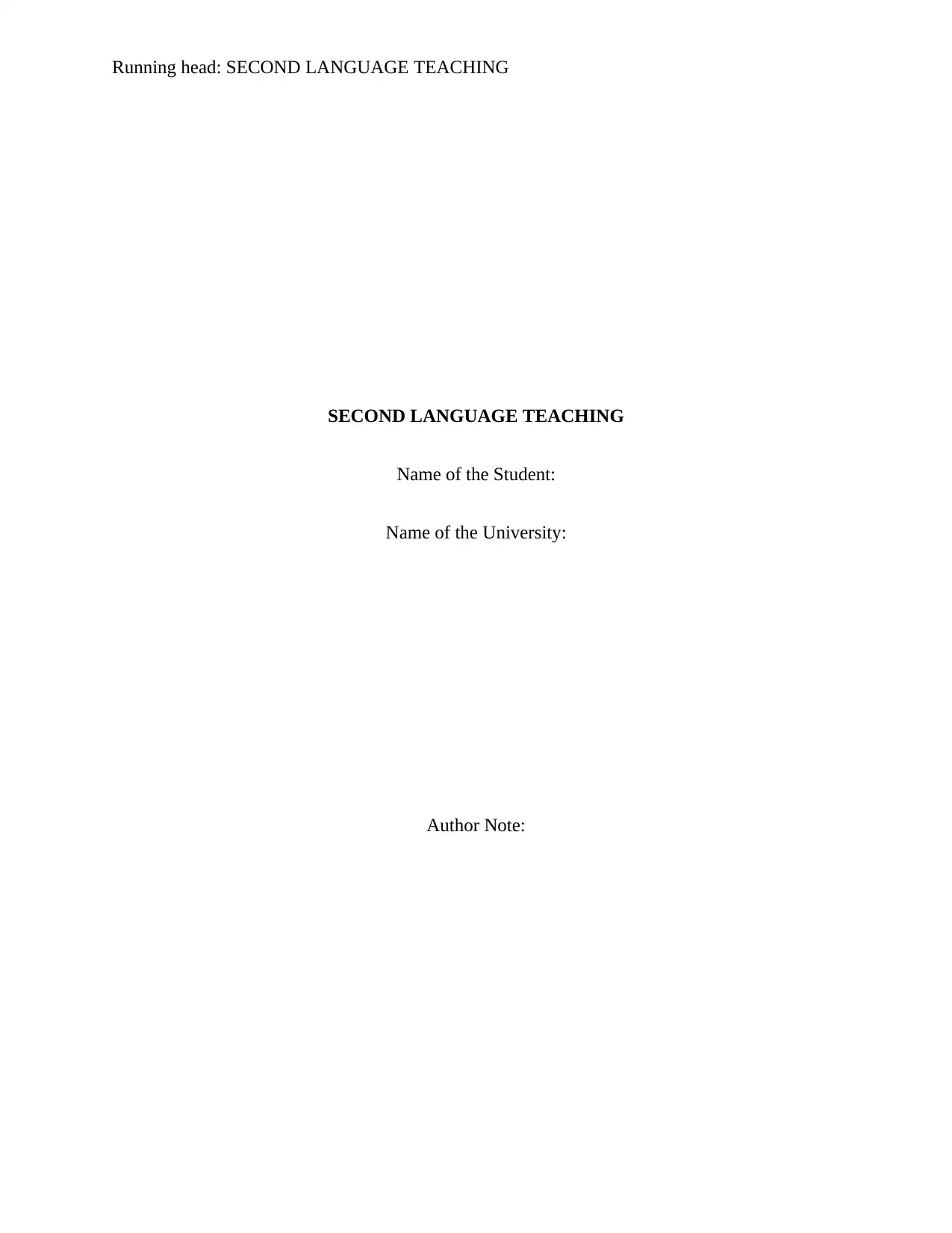
Running head: SECOND LANGUAGE TEACHING
SECOND LANGUAGE TEACHING
Name of the Student:
Name of the University:
Author Note:
SECOND LANGUAGE TEACHING
Name of the Student:
Name of the University:
Author Note:
Paraphrase This Document
Need a fresh take? Get an instant paraphrase of this document with our AI Paraphraser
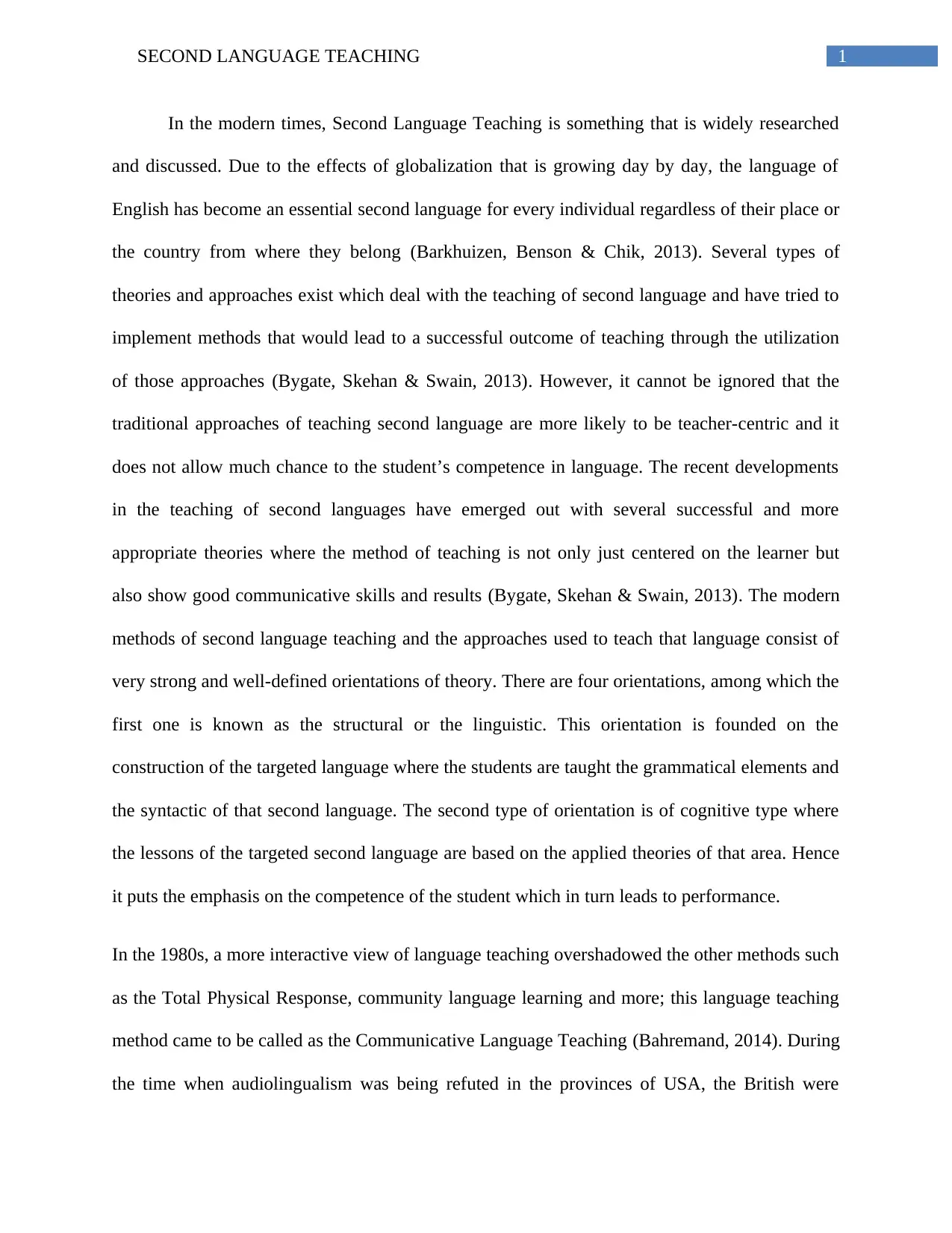
1SECOND LANGUAGE TEACHING
In the modern times, Second Language Teaching is something that is widely researched
and discussed. Due to the effects of globalization that is growing day by day, the language of
English has become an essential second language for every individual regardless of their place or
the country from where they belong (Barkhuizen, Benson & Chik, 2013). Several types of
theories and approaches exist which deal with the teaching of second language and have tried to
implement methods that would lead to a successful outcome of teaching through the utilization
of those approaches (Bygate, Skehan & Swain, 2013). However, it cannot be ignored that the
traditional approaches of teaching second language are more likely to be teacher-centric and it
does not allow much chance to the student’s competence in language. The recent developments
in the teaching of second languages have emerged out with several successful and more
appropriate theories where the method of teaching is not only just centered on the learner but
also show good communicative skills and results (Bygate, Skehan & Swain, 2013). The modern
methods of second language teaching and the approaches used to teach that language consist of
very strong and well-defined orientations of theory. There are four orientations, among which the
first one is known as the structural or the linguistic. This orientation is founded on the
construction of the targeted language where the students are taught the grammatical elements and
the syntactic of that second language. The second type of orientation is of cognitive type where
the lessons of the targeted second language are based on the applied theories of that area. Hence
it puts the emphasis on the competence of the student which in turn leads to performance.
In the 1980s, a more interactive view of language teaching overshadowed the other methods such
as the Total Physical Response, community language learning and more; this language teaching
method came to be called as the Communicative Language Teaching (Bahremand, 2014). During
the time when audiolingualism was being refuted in the provinces of USA, the British were
In the modern times, Second Language Teaching is something that is widely researched
and discussed. Due to the effects of globalization that is growing day by day, the language of
English has become an essential second language for every individual regardless of their place or
the country from where they belong (Barkhuizen, Benson & Chik, 2013). Several types of
theories and approaches exist which deal with the teaching of second language and have tried to
implement methods that would lead to a successful outcome of teaching through the utilization
of those approaches (Bygate, Skehan & Swain, 2013). However, it cannot be ignored that the
traditional approaches of teaching second language are more likely to be teacher-centric and it
does not allow much chance to the student’s competence in language. The recent developments
in the teaching of second languages have emerged out with several successful and more
appropriate theories where the method of teaching is not only just centered on the learner but
also show good communicative skills and results (Bygate, Skehan & Swain, 2013). The modern
methods of second language teaching and the approaches used to teach that language consist of
very strong and well-defined orientations of theory. There are four orientations, among which the
first one is known as the structural or the linguistic. This orientation is founded on the
construction of the targeted language where the students are taught the grammatical elements and
the syntactic of that second language. The second type of orientation is of cognitive type where
the lessons of the targeted second language are based on the applied theories of that area. Hence
it puts the emphasis on the competence of the student which in turn leads to performance.
In the 1980s, a more interactive view of language teaching overshadowed the other methods such
as the Total Physical Response, community language learning and more; this language teaching
method came to be called as the Communicative Language Teaching (Bahremand, 2014). During
the time when audiolingualism was being refuted in the provinces of USA, the British were
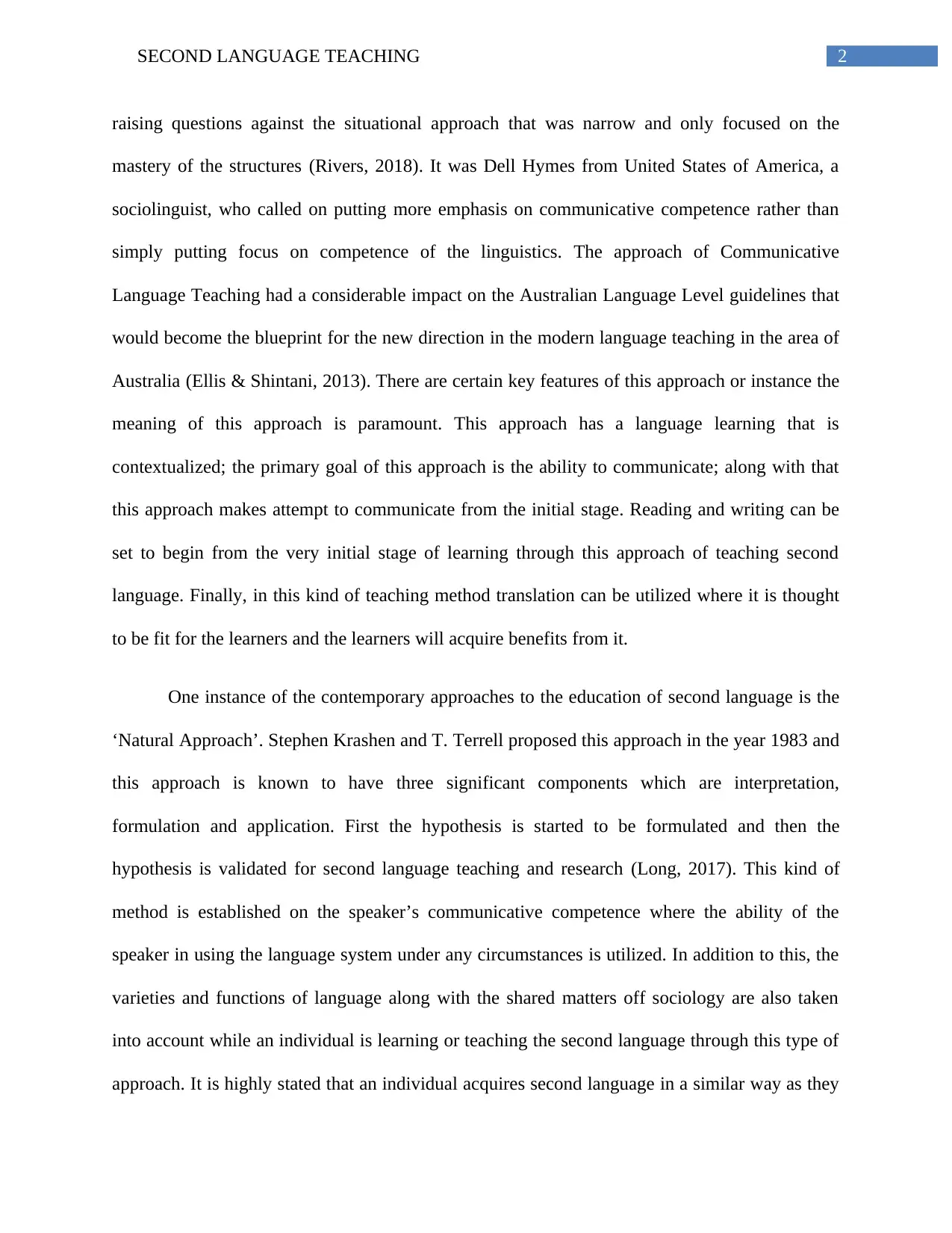
2SECOND LANGUAGE TEACHING
raising questions against the situational approach that was narrow and only focused on the
mastery of the structures (Rivers, 2018). It was Dell Hymes from United States of America, a
sociolinguist, who called on putting more emphasis on communicative competence rather than
simply putting focus on competence of the linguistics. The approach of Communicative
Language Teaching had a considerable impact on the Australian Language Level guidelines that
would become the blueprint for the new direction in the modern language teaching in the area of
Australia (Ellis & Shintani, 2013). There are certain key features of this approach or instance the
meaning of this approach is paramount. This approach has a language learning that is
contextualized; the primary goal of this approach is the ability to communicate; along with that
this approach makes attempt to communicate from the initial stage. Reading and writing can be
set to begin from the very initial stage of learning through this approach of teaching second
language. Finally, in this kind of teaching method translation can be utilized where it is thought
to be fit for the learners and the learners will acquire benefits from it.
One instance of the contemporary approaches to the education of second language is the
‘Natural Approach’. Stephen Krashen and T. Terrell proposed this approach in the year 1983 and
this approach is known to have three significant components which are interpretation,
formulation and application. First the hypothesis is started to be formulated and then the
hypothesis is validated for second language teaching and research (Long, 2017). This kind of
method is established on the speaker’s communicative competence where the ability of the
speaker in using the language system under any circumstances is utilized. In addition to this, the
varieties and functions of language along with the shared matters off sociology are also taken
into account while an individual is learning or teaching the second language through this type of
approach. It is highly stated that an individual acquires second language in a similar way as they
raising questions against the situational approach that was narrow and only focused on the
mastery of the structures (Rivers, 2018). It was Dell Hymes from United States of America, a
sociolinguist, who called on putting more emphasis on communicative competence rather than
simply putting focus on competence of the linguistics. The approach of Communicative
Language Teaching had a considerable impact on the Australian Language Level guidelines that
would become the blueprint for the new direction in the modern language teaching in the area of
Australia (Ellis & Shintani, 2013). There are certain key features of this approach or instance the
meaning of this approach is paramount. This approach has a language learning that is
contextualized; the primary goal of this approach is the ability to communicate; along with that
this approach makes attempt to communicate from the initial stage. Reading and writing can be
set to begin from the very initial stage of learning through this approach of teaching second
language. Finally, in this kind of teaching method translation can be utilized where it is thought
to be fit for the learners and the learners will acquire benefits from it.
One instance of the contemporary approaches to the education of second language is the
‘Natural Approach’. Stephen Krashen and T. Terrell proposed this approach in the year 1983 and
this approach is known to have three significant components which are interpretation,
formulation and application. First the hypothesis is started to be formulated and then the
hypothesis is validated for second language teaching and research (Long, 2017). This kind of
method is established on the speaker’s communicative competence where the ability of the
speaker in using the language system under any circumstances is utilized. In addition to this, the
varieties and functions of language along with the shared matters off sociology are also taken
into account while an individual is learning or teaching the second language through this type of
approach. It is highly stated that an individual acquires second language in a similar way as they
⊘ This is a preview!⊘
Do you want full access?
Subscribe today to unlock all pages.

Trusted by 1+ million students worldwide
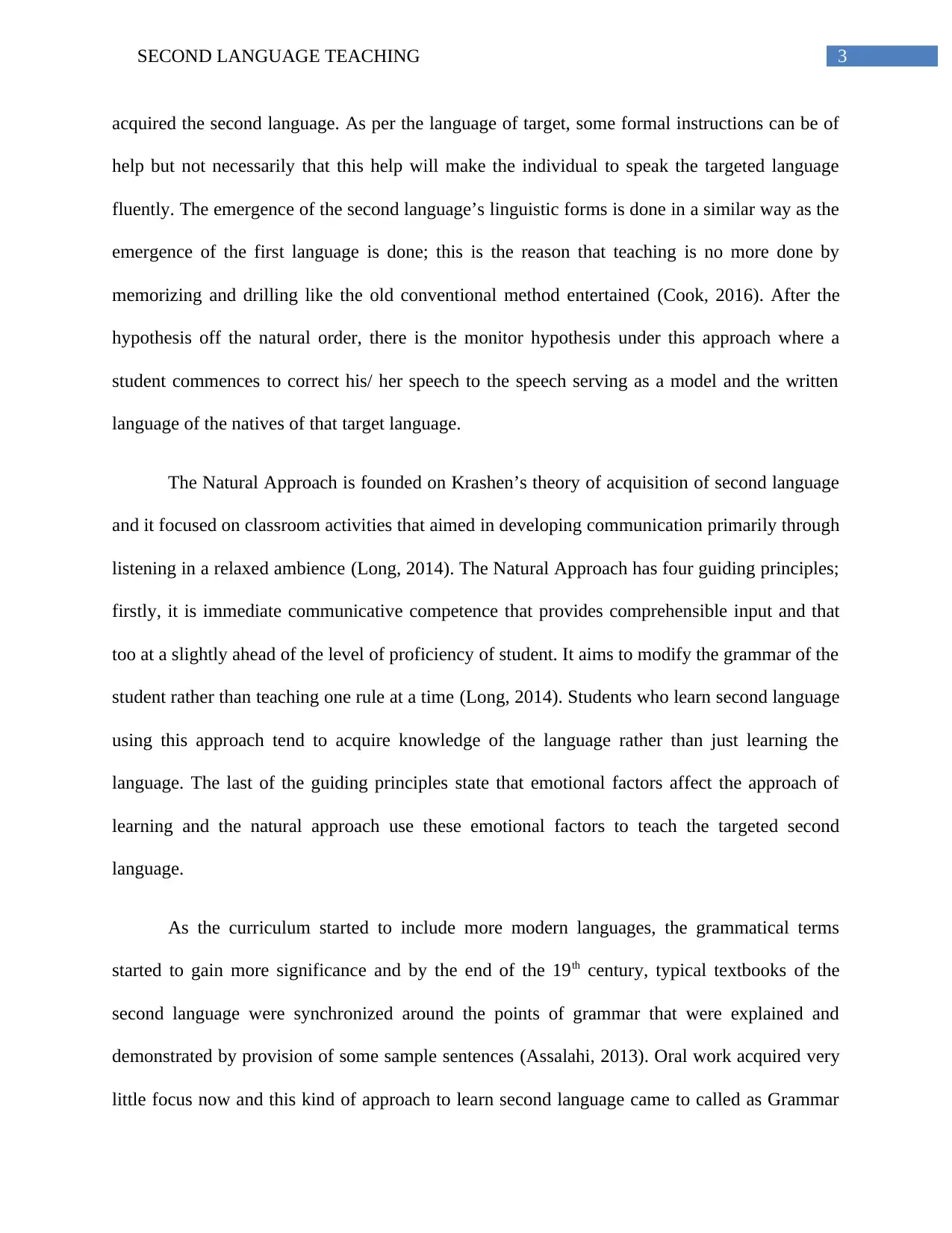
3SECOND LANGUAGE TEACHING
acquired the second language. As per the language of target, some formal instructions can be of
help but not necessarily that this help will make the individual to speak the targeted language
fluently. The emergence of the second language’s linguistic forms is done in a similar way as the
emergence of the first language is done; this is the reason that teaching is no more done by
memorizing and drilling like the old conventional method entertained (Cook, 2016). After the
hypothesis off the natural order, there is the monitor hypothesis under this approach where a
student commences to correct his/ her speech to the speech serving as a model and the written
language of the natives of that target language.
The Natural Approach is founded on Krashen’s theory of acquisition of second language
and it focused on classroom activities that aimed in developing communication primarily through
listening in a relaxed ambience (Long, 2014). The Natural Approach has four guiding principles;
firstly, it is immediate communicative competence that provides comprehensible input and that
too at a slightly ahead of the level of proficiency of student. It aims to modify the grammar of the
student rather than teaching one rule at a time (Long, 2014). Students who learn second language
using this approach tend to acquire knowledge of the language rather than just learning the
language. The last of the guiding principles state that emotional factors affect the approach of
learning and the natural approach use these emotional factors to teach the targeted second
language.
As the curriculum started to include more modern languages, the grammatical terms
started to gain more significance and by the end of the 19th century, typical textbooks of the
second language were synchronized around the points of grammar that were explained and
demonstrated by provision of some sample sentences (Assalahi, 2013). Oral work acquired very
little focus now and this kind of approach to learn second language came to called as Grammar
acquired the second language. As per the language of target, some formal instructions can be of
help but not necessarily that this help will make the individual to speak the targeted language
fluently. The emergence of the second language’s linguistic forms is done in a similar way as the
emergence of the first language is done; this is the reason that teaching is no more done by
memorizing and drilling like the old conventional method entertained (Cook, 2016). After the
hypothesis off the natural order, there is the monitor hypothesis under this approach where a
student commences to correct his/ her speech to the speech serving as a model and the written
language of the natives of that target language.
The Natural Approach is founded on Krashen’s theory of acquisition of second language
and it focused on classroom activities that aimed in developing communication primarily through
listening in a relaxed ambience (Long, 2014). The Natural Approach has four guiding principles;
firstly, it is immediate communicative competence that provides comprehensible input and that
too at a slightly ahead of the level of proficiency of student. It aims to modify the grammar of the
student rather than teaching one rule at a time (Long, 2014). Students who learn second language
using this approach tend to acquire knowledge of the language rather than just learning the
language. The last of the guiding principles state that emotional factors affect the approach of
learning and the natural approach use these emotional factors to teach the targeted second
language.
As the curriculum started to include more modern languages, the grammatical terms
started to gain more significance and by the end of the 19th century, typical textbooks of the
second language were synchronized around the points of grammar that were explained and
demonstrated by provision of some sample sentences (Assalahi, 2013). Oral work acquired very
little focus now and this kind of approach to learn second language came to called as Grammar
Paraphrase This Document
Need a fresh take? Get an instant paraphrase of this document with our AI Paraphraser
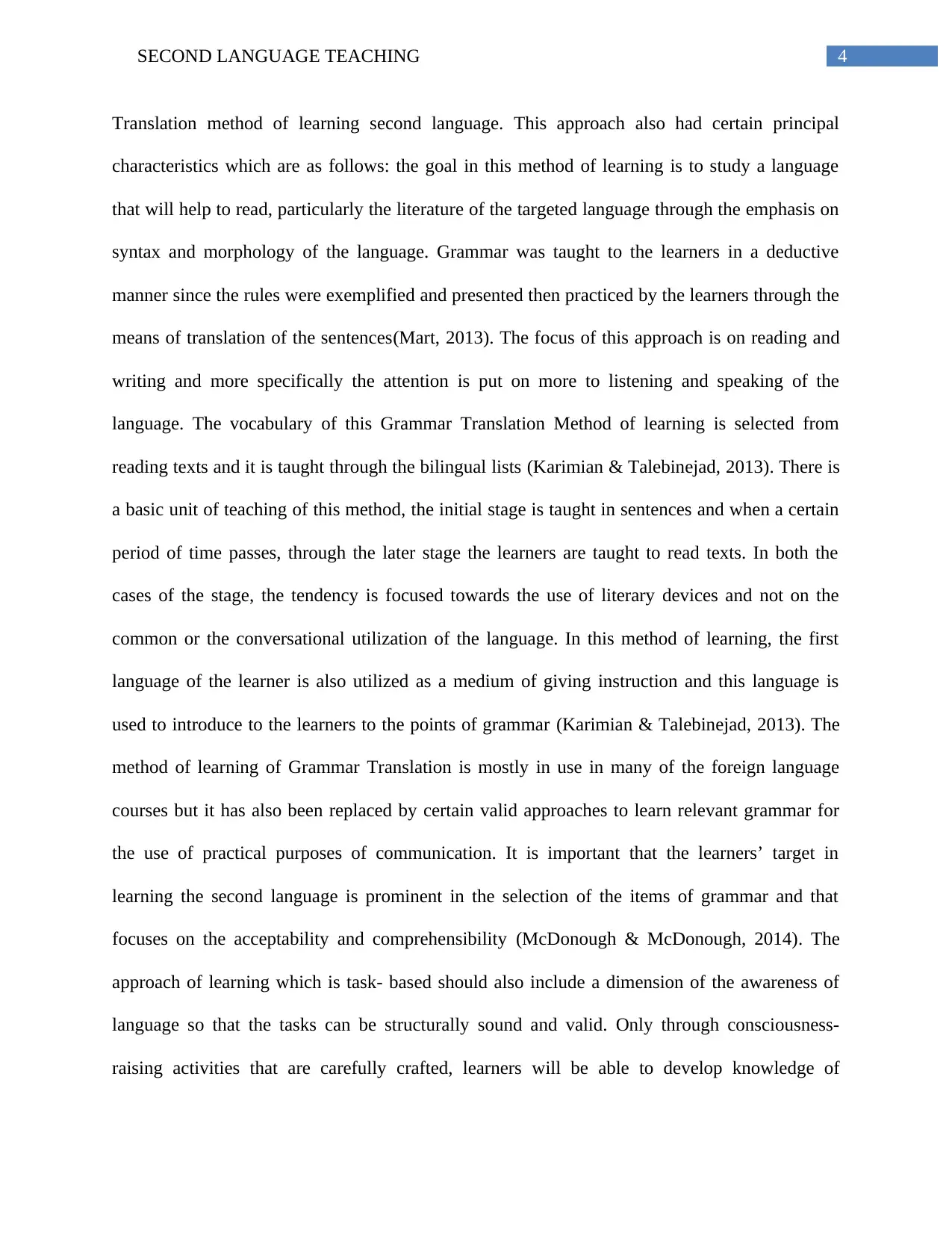
4SECOND LANGUAGE TEACHING
Translation method of learning second language. This approach also had certain principal
characteristics which are as follows: the goal in this method of learning is to study a language
that will help to read, particularly the literature of the targeted language through the emphasis on
syntax and morphology of the language. Grammar was taught to the learners in a deductive
manner since the rules were exemplified and presented then practiced by the learners through the
means of translation of the sentences(Mart, 2013). The focus of this approach is on reading and
writing and more specifically the attention is put on more to listening and speaking of the
language. The vocabulary of this Grammar Translation Method of learning is selected from
reading texts and it is taught through the bilingual lists (Karimian & Talebinejad, 2013). There is
a basic unit of teaching of this method, the initial stage is taught in sentences and when a certain
period of time passes, through the later stage the learners are taught to read texts. In both the
cases of the stage, the tendency is focused towards the use of literary devices and not on the
common or the conversational utilization of the language. In this method of learning, the first
language of the learner is also utilized as a medium of giving instruction and this language is
used to introduce to the learners to the points of grammar (Karimian & Talebinejad, 2013). The
method of learning of Grammar Translation is mostly in use in many of the foreign language
courses but it has also been replaced by certain valid approaches to learn relevant grammar for
the use of practical purposes of communication. It is important that the learners’ target in
learning the second language is prominent in the selection of the items of grammar and that
focuses on the acceptability and comprehensibility (McDonough & McDonough, 2014). The
approach of learning which is task- based should also include a dimension of the awareness of
language so that the tasks can be structurally sound and valid. Only through consciousness-
raising activities that are carefully crafted, learners will be able to develop knowledge of
Translation method of learning second language. This approach also had certain principal
characteristics which are as follows: the goal in this method of learning is to study a language
that will help to read, particularly the literature of the targeted language through the emphasis on
syntax and morphology of the language. Grammar was taught to the learners in a deductive
manner since the rules were exemplified and presented then practiced by the learners through the
means of translation of the sentences(Mart, 2013). The focus of this approach is on reading and
writing and more specifically the attention is put on more to listening and speaking of the
language. The vocabulary of this Grammar Translation Method of learning is selected from
reading texts and it is taught through the bilingual lists (Karimian & Talebinejad, 2013). There is
a basic unit of teaching of this method, the initial stage is taught in sentences and when a certain
period of time passes, through the later stage the learners are taught to read texts. In both the
cases of the stage, the tendency is focused towards the use of literary devices and not on the
common or the conversational utilization of the language. In this method of learning, the first
language of the learner is also utilized as a medium of giving instruction and this language is
used to introduce to the learners to the points of grammar (Karimian & Talebinejad, 2013). The
method of learning of Grammar Translation is mostly in use in many of the foreign language
courses but it has also been replaced by certain valid approaches to learn relevant grammar for
the use of practical purposes of communication. It is important that the learners’ target in
learning the second language is prominent in the selection of the items of grammar and that
focuses on the acceptability and comprehensibility (McDonough & McDonough, 2014). The
approach of learning which is task- based should also include a dimension of the awareness of
language so that the tasks can be structurally sound and valid. Only through consciousness-
raising activities that are carefully crafted, learners will be able to develop knowledge of
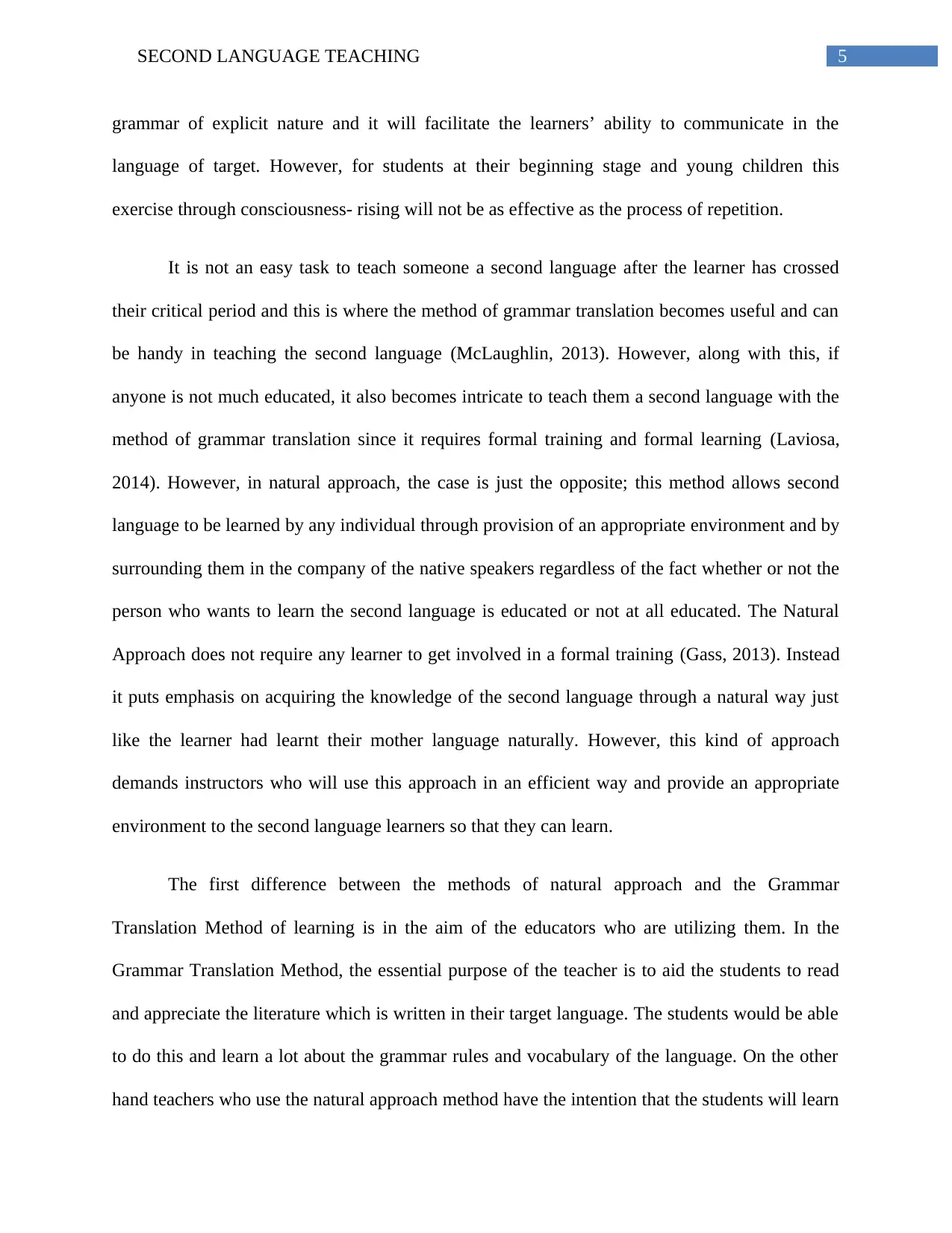
5SECOND LANGUAGE TEACHING
grammar of explicit nature and it will facilitate the learners’ ability to communicate in the
language of target. However, for students at their beginning stage and young children this
exercise through consciousness- rising will not be as effective as the process of repetition.
It is not an easy task to teach someone a second language after the learner has crossed
their critical period and this is where the method of grammar translation becomes useful and can
be handy in teaching the second language (McLaughlin, 2013). However, along with this, if
anyone is not much educated, it also becomes intricate to teach them a second language with the
method of grammar translation since it requires formal training and formal learning (Laviosa,
2014). However, in natural approach, the case is just the opposite; this method allows second
language to be learned by any individual through provision of an appropriate environment and by
surrounding them in the company of the native speakers regardless of the fact whether or not the
person who wants to learn the second language is educated or not at all educated. The Natural
Approach does not require any learner to get involved in a formal training (Gass, 2013). Instead
it puts emphasis on acquiring the knowledge of the second language through a natural way just
like the learner had learnt their mother language naturally. However, this kind of approach
demands instructors who will use this approach in an efficient way and provide an appropriate
environment to the second language learners so that they can learn.
The first difference between the methods of natural approach and the Grammar
Translation Method of learning is in the aim of the educators who are utilizing them. In the
Grammar Translation Method, the essential purpose of the teacher is to aid the students to read
and appreciate the literature which is written in their target language. The students would be able
to do this and learn a lot about the grammar rules and vocabulary of the language. On the other
hand teachers who use the natural approach method have the intention that the students will learn
grammar of explicit nature and it will facilitate the learners’ ability to communicate in the
language of target. However, for students at their beginning stage and young children this
exercise through consciousness- rising will not be as effective as the process of repetition.
It is not an easy task to teach someone a second language after the learner has crossed
their critical period and this is where the method of grammar translation becomes useful and can
be handy in teaching the second language (McLaughlin, 2013). However, along with this, if
anyone is not much educated, it also becomes intricate to teach them a second language with the
method of grammar translation since it requires formal training and formal learning (Laviosa,
2014). However, in natural approach, the case is just the opposite; this method allows second
language to be learned by any individual through provision of an appropriate environment and by
surrounding them in the company of the native speakers regardless of the fact whether or not the
person who wants to learn the second language is educated or not at all educated. The Natural
Approach does not require any learner to get involved in a formal training (Gass, 2013). Instead
it puts emphasis on acquiring the knowledge of the second language through a natural way just
like the learner had learnt their mother language naturally. However, this kind of approach
demands instructors who will use this approach in an efficient way and provide an appropriate
environment to the second language learners so that they can learn.
The first difference between the methods of natural approach and the Grammar
Translation Method of learning is in the aim of the educators who are utilizing them. In the
Grammar Translation Method, the essential purpose of the teacher is to aid the students to read
and appreciate the literature which is written in their target language. The students would be able
to do this and learn a lot about the grammar rules and vocabulary of the language. On the other
hand teachers who use the natural approach method have the intention that the students will learn
⊘ This is a preview!⊘
Do you want full access?
Subscribe today to unlock all pages.

Trusted by 1+ million students worldwide
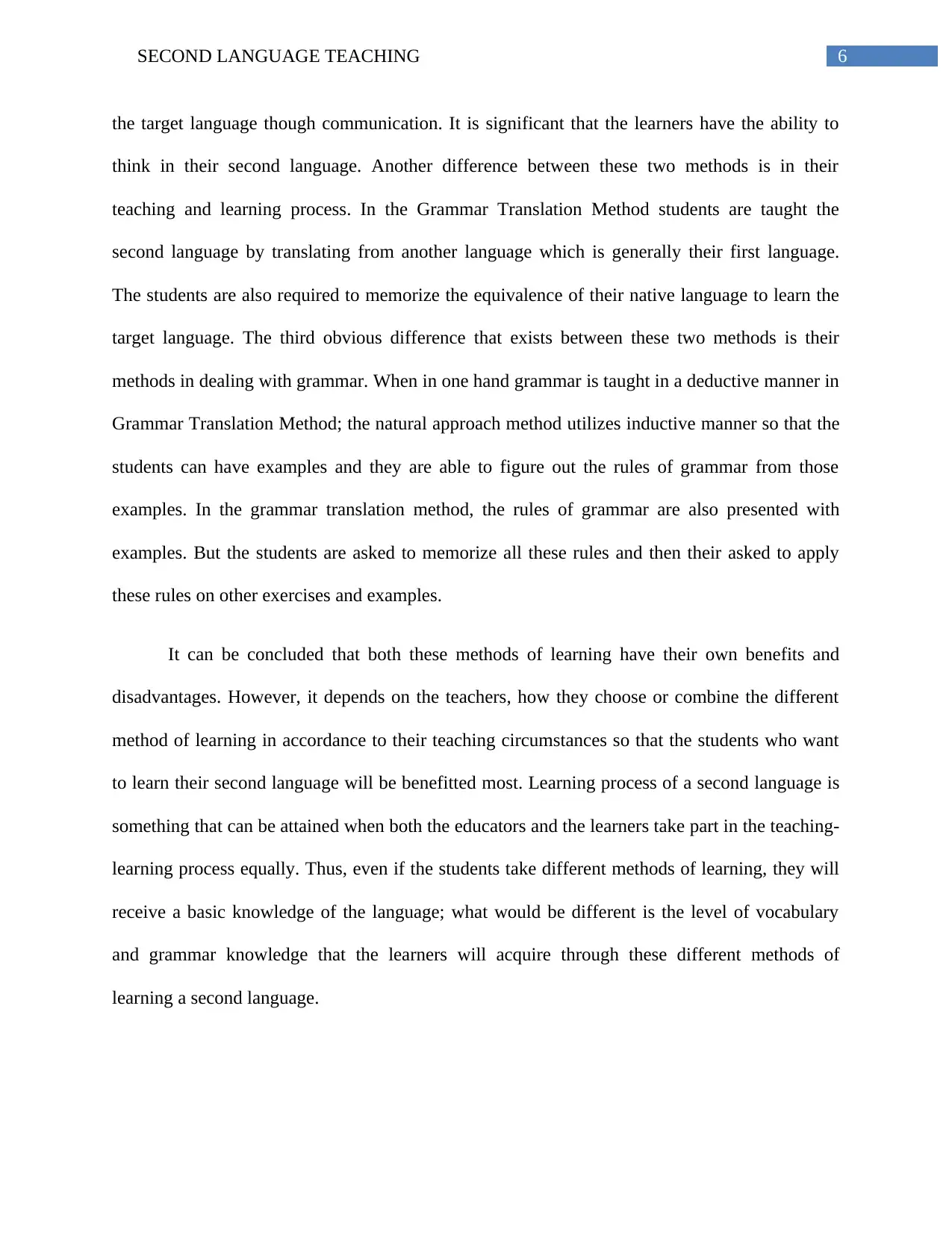
6SECOND LANGUAGE TEACHING
the target language though communication. It is significant that the learners have the ability to
think in their second language. Another difference between these two methods is in their
teaching and learning process. In the Grammar Translation Method students are taught the
second language by translating from another language which is generally their first language.
The students are also required to memorize the equivalence of their native language to learn the
target language. The third obvious difference that exists between these two methods is their
methods in dealing with grammar. When in one hand grammar is taught in a deductive manner in
Grammar Translation Method; the natural approach method utilizes inductive manner so that the
students can have examples and they are able to figure out the rules of grammar from those
examples. In the grammar translation method, the rules of grammar are also presented with
examples. But the students are asked to memorize all these rules and then their asked to apply
these rules on other exercises and examples.
It can be concluded that both these methods of learning have their own benefits and
disadvantages. However, it depends on the teachers, how they choose or combine the different
method of learning in accordance to their teaching circumstances so that the students who want
to learn their second language will be benefitted most. Learning process of a second language is
something that can be attained when both the educators and the learners take part in the teaching-
learning process equally. Thus, even if the students take different methods of learning, they will
receive a basic knowledge of the language; what would be different is the level of vocabulary
and grammar knowledge that the learners will acquire through these different methods of
learning a second language.
the target language though communication. It is significant that the learners have the ability to
think in their second language. Another difference between these two methods is in their
teaching and learning process. In the Grammar Translation Method students are taught the
second language by translating from another language which is generally their first language.
The students are also required to memorize the equivalence of their native language to learn the
target language. The third obvious difference that exists between these two methods is their
methods in dealing with grammar. When in one hand grammar is taught in a deductive manner in
Grammar Translation Method; the natural approach method utilizes inductive manner so that the
students can have examples and they are able to figure out the rules of grammar from those
examples. In the grammar translation method, the rules of grammar are also presented with
examples. But the students are asked to memorize all these rules and then their asked to apply
these rules on other exercises and examples.
It can be concluded that both these methods of learning have their own benefits and
disadvantages. However, it depends on the teachers, how they choose or combine the different
method of learning in accordance to their teaching circumstances so that the students who want
to learn their second language will be benefitted most. Learning process of a second language is
something that can be attained when both the educators and the learners take part in the teaching-
learning process equally. Thus, even if the students take different methods of learning, they will
receive a basic knowledge of the language; what would be different is the level of vocabulary
and grammar knowledge that the learners will acquire through these different methods of
learning a second language.
Paraphrase This Document
Need a fresh take? Get an instant paraphrase of this document with our AI Paraphraser
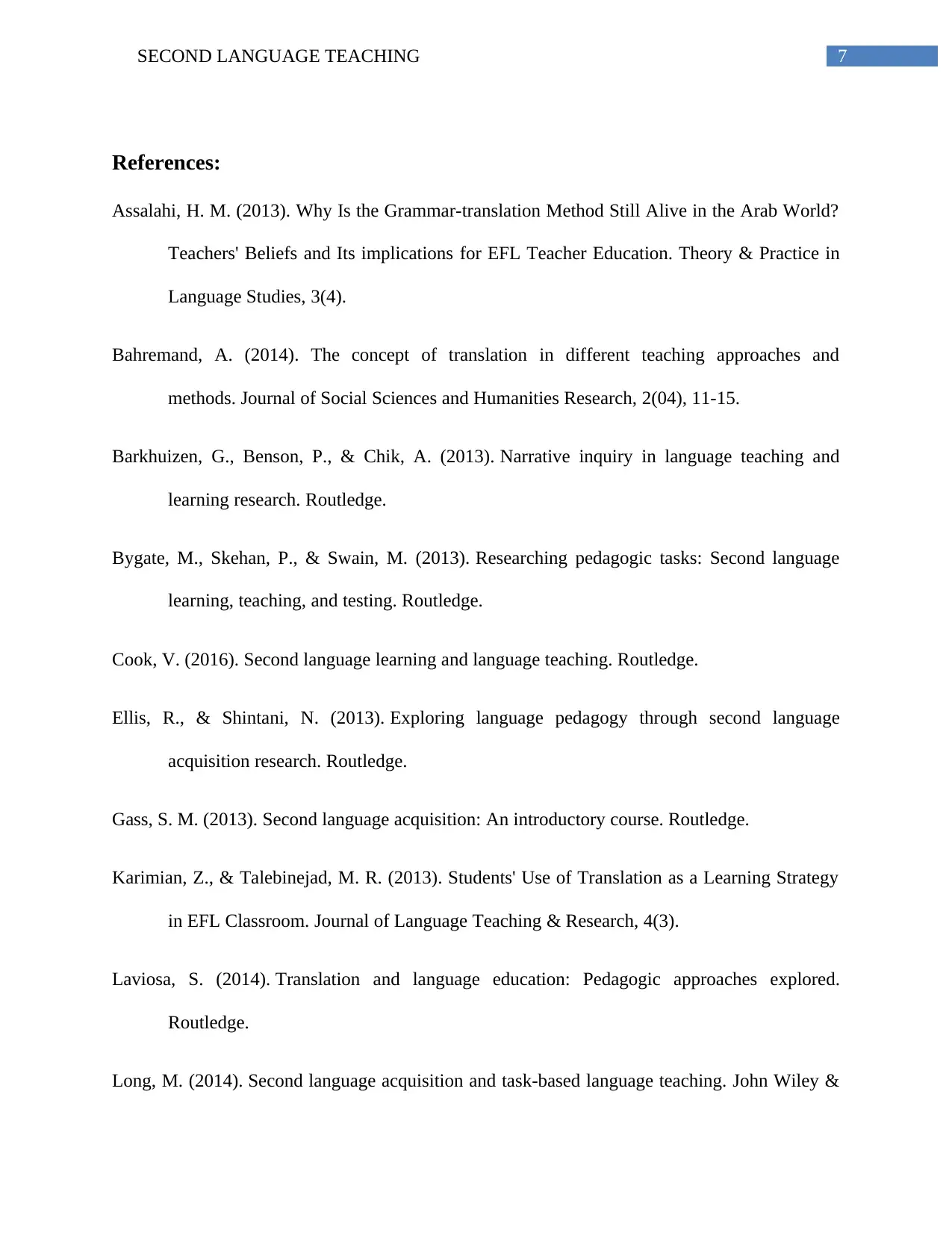
7SECOND LANGUAGE TEACHING
References:
Assalahi, H. M. (2013). Why Is the Grammar-translation Method Still Alive in the Arab World?
Teachers' Beliefs and Its implications for EFL Teacher Education. Theory & Practice in
Language Studies, 3(4).
Bahremand, A. (2014). The concept of translation in different teaching approaches and
methods. Journal of Social Sciences and Humanities Research, 2(04), 11-15.
Barkhuizen, G., Benson, P., & Chik, A. (2013). Narrative inquiry in language teaching and
learning research. Routledge.
Bygate, M., Skehan, P., & Swain, M. (2013). Researching pedagogic tasks: Second language
learning, teaching, and testing. Routledge.
Cook, V. (2016). Second language learning and language teaching. Routledge.
Ellis, R., & Shintani, N. (2013). Exploring language pedagogy through second language
acquisition research. Routledge.
Gass, S. M. (2013). Second language acquisition: An introductory course. Routledge.
Karimian, Z., & Talebinejad, M. R. (2013). Students' Use of Translation as a Learning Strategy
in EFL Classroom. Journal of Language Teaching & Research, 4(3).
Laviosa, S. (2014). Translation and language education: Pedagogic approaches explored.
Routledge.
Long, M. (2014). Second language acquisition and task-based language teaching. John Wiley &
References:
Assalahi, H. M. (2013). Why Is the Grammar-translation Method Still Alive in the Arab World?
Teachers' Beliefs and Its implications for EFL Teacher Education. Theory & Practice in
Language Studies, 3(4).
Bahremand, A. (2014). The concept of translation in different teaching approaches and
methods. Journal of Social Sciences and Humanities Research, 2(04), 11-15.
Barkhuizen, G., Benson, P., & Chik, A. (2013). Narrative inquiry in language teaching and
learning research. Routledge.
Bygate, M., Skehan, P., & Swain, M. (2013). Researching pedagogic tasks: Second language
learning, teaching, and testing. Routledge.
Cook, V. (2016). Second language learning and language teaching. Routledge.
Ellis, R., & Shintani, N. (2013). Exploring language pedagogy through second language
acquisition research. Routledge.
Gass, S. M. (2013). Second language acquisition: An introductory course. Routledge.
Karimian, Z., & Talebinejad, M. R. (2013). Students' Use of Translation as a Learning Strategy
in EFL Classroom. Journal of Language Teaching & Research, 4(3).
Laviosa, S. (2014). Translation and language education: Pedagogic approaches explored.
Routledge.
Long, M. (2014). Second language acquisition and task-based language teaching. John Wiley &
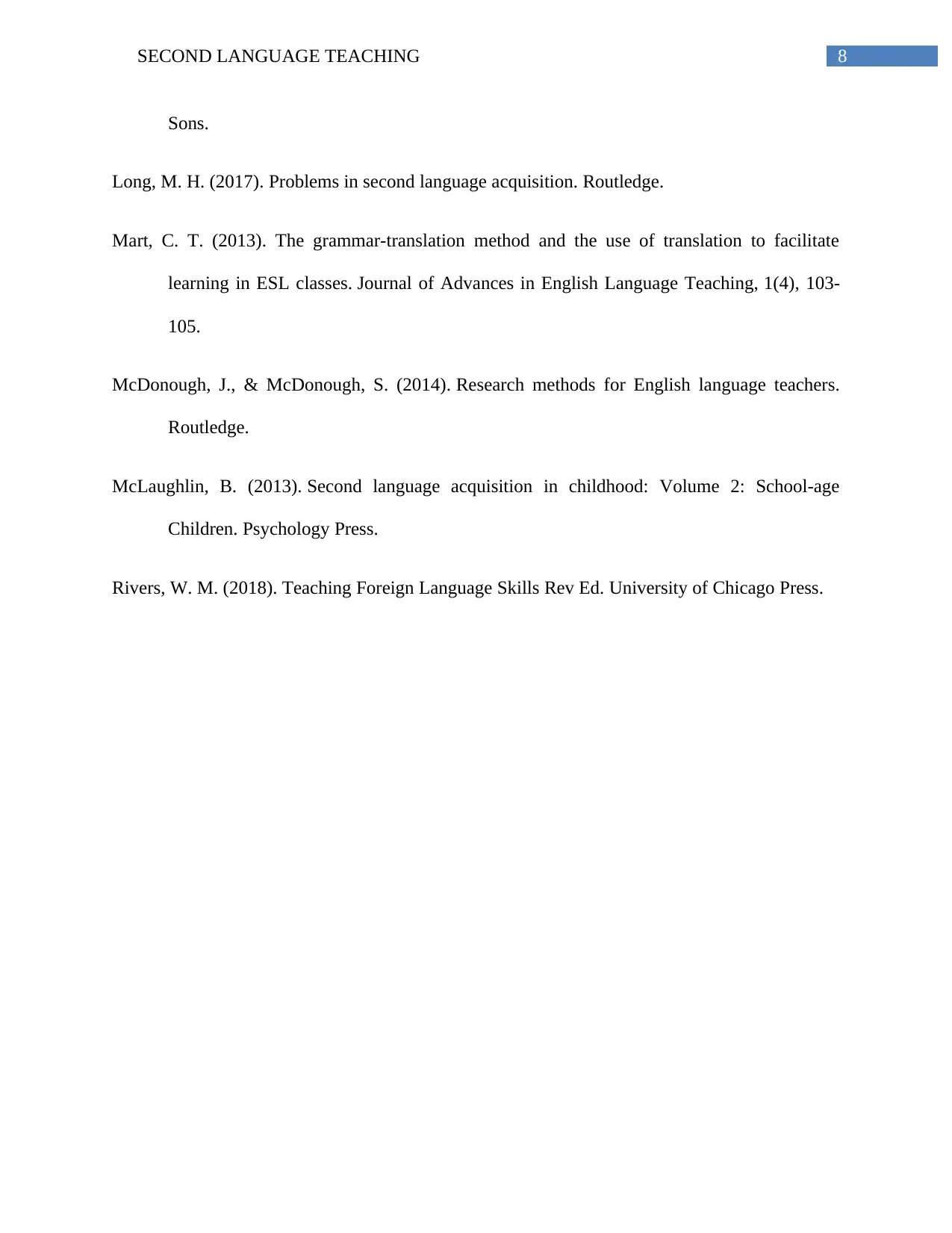
8SECOND LANGUAGE TEACHING
Sons.
Long, M. H. (2017). Problems in second language acquisition. Routledge.
Mart, C. T. (2013). The grammar-translation method and the use of translation to facilitate
learning in ESL classes. Journal of Advances in English Language Teaching, 1(4), 103-
105.
McDonough, J., & McDonough, S. (2014). Research methods for English language teachers.
Routledge.
McLaughlin, B. (2013). Second language acquisition in childhood: Volume 2: School-age
Children. Psychology Press.
Rivers, W. M. (2018). Teaching Foreign Language Skills Rev Ed. University of Chicago Press.
Sons.
Long, M. H. (2017). Problems in second language acquisition. Routledge.
Mart, C. T. (2013). The grammar-translation method and the use of translation to facilitate
learning in ESL classes. Journal of Advances in English Language Teaching, 1(4), 103-
105.
McDonough, J., & McDonough, S. (2014). Research methods for English language teachers.
Routledge.
McLaughlin, B. (2013). Second language acquisition in childhood: Volume 2: School-age
Children. Psychology Press.
Rivers, W. M. (2018). Teaching Foreign Language Skills Rev Ed. University of Chicago Press.
⊘ This is a preview!⊘
Do you want full access?
Subscribe today to unlock all pages.

Trusted by 1+ million students worldwide
1 out of 9
Related Documents
Your All-in-One AI-Powered Toolkit for Academic Success.
+13062052269
info@desklib.com
Available 24*7 on WhatsApp / Email
![[object Object]](/_next/static/media/star-bottom.7253800d.svg)
Unlock your academic potential
Copyright © 2020–2025 A2Z Services. All Rights Reserved. Developed and managed by ZUCOL.





